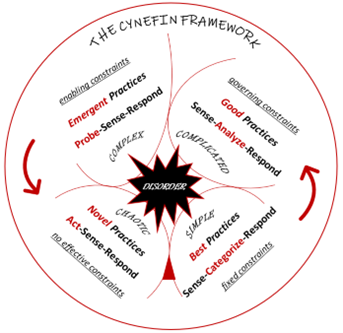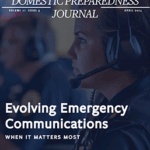- Articles, Communication & Interoperability, Emergency Management, Public Health
- Eva Jernegan
Violence prevention, hardening potential targets, eliminating threats, and reducing victim count are shared goals among all public safety stakeholders during mass casualty and other high-threat incidents. However, priorities and strategies among first responders and regional policymakers vary, and bad actors are often a step ahead of those committed to saving lives. Timely development and implementation of best practices, flexible processes, and an enhanced capacity to collaborate when it matters the most avoid multiple points of failure – detrimental to the overall capacity of a community to prevent or respond to attacks and its ability to recover.
The threat of violence is constantly evolving and creates new challenges for first responders, particularly during complex coordinated attacks – the type of attacks that include various modalities of weapons and tactics utilized by bad actors and require a significant mobilization of resources. One example of a complex coordinated attack (or a high-threat attack) is an incident where an armed subject uses fire to divert and complicate rescue efforts. Fire-as-a-weapon incidents differ from arson in their complexity and specific characteristics that require special considerations during an integrated response. The use of smoke or a fire alarm pulled for nefarious purposes are not fire attributes that fit the traditional arson classification within national fire reporting systems. Fire, emergency medical systems (EMS), and police are expected to respond to a fire-as-a-weapon scene, but it becomes difficult to decide who is in charge and how best to mitigate the threat while bullets are flying and fire is blazing. Complex coordinated attacks require that incident commanders reconsider their agencies’ respective roles and implement innovative tactics that involve collaboration and mutual understanding of priorities.
Fire-as-a-weapon incidents differ from arson in their complexity and specific characteristics that require special considerations during an integrated response.
The Rescue Task Force Concept
One way to mitigate these limitations is to set up a unified incident command post, where fire and police personnel in charge work together, sharing intelligence and making informed decisions in real-time. Both officers and EMS would go in as a unit to maximize time and effort in saving lives. The Rescue Task Force is a concept developed by Arlington County (Virginia) Fire Department in 2013 and actively socialized and implemented by the Arlington County High Threat Response Program (HTRP). The Rescue Task Force is a first responder tactic that deploys a minimum of two police and one EMS personnel, who then establish hot, warm, and cold zones where the unit can operate to a different extent in treating and extracting victims while staying vigilant of the threat. Standardized terminology, improved communication, and reasonable operational predictability in an otherwise unpredictable situation are essential to the success of an integrated response.
The HTRP engaged 21 agencies and more than 100 subject matter experts across Northern Virginia to improve regional and multiagency collaboration and first responder interoperability. The subject matter experts formed working groups that looked at personal protective equipment and how to operate in hazardous conditions, improved regional information and intelligence sharing, and enhanced mutual aid and resource deployment practices during low- and high-probability attacks. The project utilized subject matter experts to strengthen existing capabilities and create new integrated tactics and strategies to respond to complex coordinated attacks by looking at, for example, active violence, chemical/biological/radiological/nuclear (CBRN) threats, explosives, and civil disturbance. The HTRP team conducted numerous tabletop exercises for incident commanders, brainstorming discussions engaging emergency communication centers, hospitals, federal partners, and other experts, as well as training for SWAT officers and EMS personnel. Hands-on exercises included cross-training, simulating complex coordinated attacks response, and practicing Rescue Task Force and other innovative tactics. Training that engages all stakeholders in emergency response can improve the efficiency of the response and reduce the risk of first responder injuries when operating in complex hostile environments. For example, the HTRP implemented regional SWAT practices that allow officers to operate a hose from inside an armored personnel carrier in a scenario where a bad actor is shooting from a building set on fire (see photo above).
One of the program’s deliverables is a large repository of vetted resources compiled during the five-year term of the project, including vetted policies and procedures, after-action reports, training resources, and reference articles. Two databases provide an innovative look at high-threat incidents – the High Threat Incident Database and the Fire as a Weapon Incidents Database – and track domestic and international incidents. The databases evaluate incident components that may provide lessons learned and improve the overall awareness around common tactics and targets, as well as emerging threats involving technology or hybrid methods. First responders can view these resources by requesting access to the High Threat Response Repository hosted on the Northern Virginia Response System’s (NVERS) website. Even though the HTRP does not exist at its full capacity due to the expiration of the federal grant funding, a small number of dedicated personnel still socialize the deliverables and update the repository. The HTRP is currently leading an effort to address new regional gaps and challenges. Multiagency representatives comprise the Critical Infrastructure working group, responsible for the identification, preplanning, and mapping of sites, buildings, and systems, as well as the Cyber working group, developing backup plans and operations to put in place in the aftermath of an incident. Many public safety agencies do not possess the bandwidth to conduct research and lack access to funding to run trial programs. As such, larger and better-equipped agencies in the region have the responsibility to establish mutual aid agreements.
The Cynefin Framework
To further explore complex and chaotic environments, leaders tasked with improving domestic preparedness can consider the Cynefin Framework, which aims to make sense of disorder and improve functionality and decision-making within a system. First responders are trained to operate temporarily in complex and chaotic environments where risks (injury or death) and rewards (saving lives) are high, and adaptability is paramount. Those involved in planning and operational support often work in the complicated domain and bring a different perspective to the conversation. In the context of emergency response, lingering in the clear (simple) domain where solutions seem obvious, without considering the inevitable evolution of violence, may lead to complacency and diminish efforts to get ahead of bad actors. Leaders who invest in better ways to understand the threat and build new and improved capacities that engage the entirety of the public safety community may avoid a collapse into the chaotic domain, where recovery is long and challenging, and the cost is high (in every sense of the word).
To further illustrate the relevance of the model and expand on its utility in making sense of how to prepare for and respond to incidents, it can be further extrapolated that mass casualty incidents and other high-threat incidents throw a system into immediate and inevitable chaos. In those instances, the impact extends beyond the emergency response itself and takes over the whole community affected by the loss. In moments of peace, this dynamic system can be viewed as an opportunity for a controlled transition across different domains while maintaining constant awareness. Making sense of chaos and disorder by analyzing prior successes and failures benefits the overall local, regional, and national preparedness strategy. Engaging multidisciplinary teams of subject matter experts used to operating in any of the Cynefin Framework domains and strategically placing quickly and efficiently deployable human and other resources may be what the public safety community needs to prevent another failure of imagination as highlighted in the 9/11 Commission Report.

Coordinated Multiagency Actions
Complex coordinated attacks require (1) fire and police departments to respond and (2) a timely implementation of a multiagency, multidisciplinary network of subject matter experts who work together to analyze lessons learned from prior incidents. Additional steps leaders can take toward improving domestic preparedness include:
- Training intelligence liaison officers,
- Revisiting the utility and structure of fusion centers and how effectively intelligence is shared, and
- Engaging academia and counterterrorism experts in gaps and needs assessments and think tanks.
Bitter memories of the inability to recognize the importance of relationship building, cross-training, and operational synchronization before an incident occurs have triggered the urgent need for a whole-of-community approach. Until Help Arrives is an Arlington County-led initiative that teaches citizens how to help their communities save lives until professional responders arrive, including recognizing threats, navigating potentially lethal environments, and providing basic casualty care. Mental health is another critical factor for building resilience – first responders and those from vulnerable populations need access to the appropriate resources and services. Every community, particularly schools, needs robust multidisciplinary threat assessment teams (an evidence-based best practice) that address early concerns of individuals on the pathway to violence. Such teams can develop successful threat management strategies for de-escalation tailored to the specific context of a person and situation and provide access to services.
To facilitate violence prevention and increase the chance for survival even during complex incidents, communities should:
- Help first responders navigate high-threat environments as safely as possible,
- Educate leaders on the importance of understanding the practical implications of informed decision-making, and
- Empower the community at large to be an active contributor to public safety.
An integrated public safety approach and multidisciplinary think tanks are vital to improving domestic preparedness in a constantly evolving threat environment. Leaders from all levels of government and stakeholders from all public safety agencies must learn from past failures and successes equally and develop policies, procedures, and training that enable first responders to work together and save lives.

Eva Jernegan
Eva Jernegan holds a master’s in Forensic Psychology from George Washington University and works with the intelligence, violence prevention, and national security communities. Eva was the lead researcher for the Arlington County High Threat Response Program, with investigative and threat assessment training and practical experience in various settings. She has been involved in multiple initiatives to build capacities for the public safety community and identify and mitigate local, state, and national threats. Currently, Eva supports the federal government in efforts to counter Weapons of Mass Destruction (WMD) terrorism on the international level and serves on the Board for the D.C. Mid-Atlantic Chapter of the Association of Threat Assessment Professionals (ATAP).
- Eva Jerneganhttps://domprep.com/author/eva-jernegan






